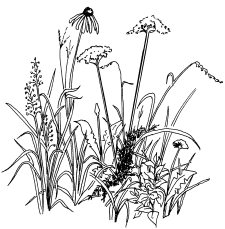
Indicator Species
Henslows Sparrow: Ammodramus henslowii
IUCN (International Union for the Conservation of Nature) status: Near Threatened
Natural history:
Neotropical Migrant bird. (migratory between north and central/south America) Summers in great plains east through the Ohio valley. Winters on the gulf coast north to the Carolinas. Insectivorous. Primary population threat is habitat loss. It is a very secretive species rarely seen, but often heard singing in the early mornings or especially at dusk. Preyed upon by mammals such as raccoons, opossum, or birds of prey such as hawks or owls. All birds are susceptible to the accumulation of neonic insecticides within the food chain.
Habitat:
Native prairies that experience regular burning. Nests are built hidden within 3 -5 foot tall stands of native grasses. This species prefers moist tall
grass prairies such as Tucker Prairie.
Range:
http://maps.iucnredlist.org/map.html?id=22721138
Links:
http://www.allaboutbirds.org/guide/Henslows_Sparrow/id
https://www.audubon.org/field-guide/bird/henslows-sparrow
http://climate.audubon.org/birds/henspa/henslows-sparrow
https://en.wikipedia.org/wiki/Henslow's_sparrow
Guiding questions for predicting the future of this species at Tucker Prairie:
-
Does this species account lend evidence to support the ability to adapt to changing vegetation, soil moisture, and climate?
-
Are the habitat requirements for this species broad or specific?
-
What is your prediction for the success of this species at Tucker Prairie if climate change results in a gradual conversion of Tucker Prairie from native prairie to shrubs and eventually woodland?
-
What does this species eat? What other species eats the Henslow’s Sparrow?
-
Using your answers to the previous three questions as a guide, compare and contrast the storylines for Henslow’s sparrows and Bell’s vireo in a changing climate. How are they similar and different?
-
The range map shows the summer and winter migratory areas. Given the use of two distinct habitat areas, how might climate change be especially challenging on a migratory species such as the Henslow’s sparrow?



